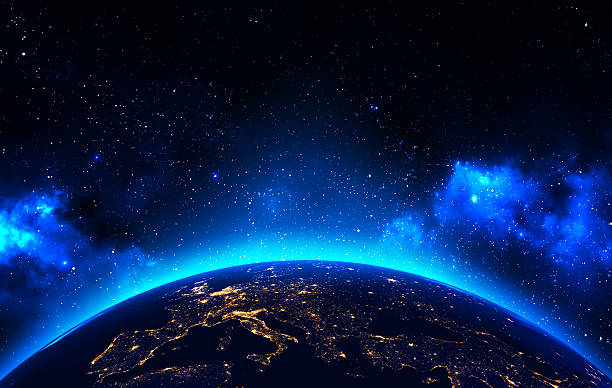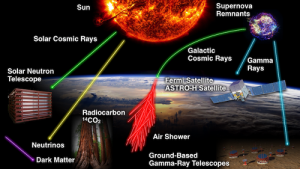The sun, like the leader of our cosmic family, is the biggest source of power in the Milky Way. Its energy travels through the Solar System, reaching all the planets, including our Earth. When these energy waves come to Earth, they turn into something called cosmic radiation. It’s like a cosmic dance happening in two ways: the first type brings strong particles like protons and electrons, and
the second type has weaker particles like muons, pions, and neutrinos.
These cosmic waves are kind of like messengers from the sun. They enter Earth’s atmosphere, reach the surface, and become what we call cosmic radiation. There are two main types: the strong kind that comes directly to the surface, and the weaker kind that includes different particles.
So, it’s like the sun, our cosmic leader, sending messages that turn into a dance of energy here on our blue planet.
As we explore the cosmic narrative, a diverse array of cosmogenic isotopes emerges. Four notable isotopes, Carbon-14, Beryllium-7, Hydrogen-3, and Sodium-22, stand out for their unique properties and applications:
1. Carbon-14 (C-14):
Use: Widely applied in radiocarbon dating, determining the age of organic materials.
Harm: Excessive exposure to C-14 poses health risks, contributing to ionization and potential tissue damage.
2. Beryllium-7 (Be-7):
Use: Acts as a tracer in atmospheric studies, aiding environmental research.
Harm: While Be-7 itself is relatively benign, its decay products may contribute to radiation exposure.
3. Hydrogen-3 (H-3 or Tritium):
Use: Applied in radio luminescent devices, biomedical research as a tracer, and in nuclear weapons.
Harm: Tritium exposure can pose health risks, particularly when incorporated into water sources.
4. Sodium-22 (Na-22):
Use: Employed in medical imaging, especially in positron emission tomography (PET) scans.
Harm: Exposure to Na-22 carries potential risks due to its ionizing nature, impacting living tissues.
The cosmic interaction with Earth’s atmosphere shapes our biosphere and oceans. Cosmic rays, colliding with atoms, lead to the formation of isotopes that attach to aerosol molecules, eventually settling on Earth’s surface. This dance of cosmic radiation profoundly influences our world.
Factors such as altitude, latitude, and effective shielding modulate the impact of cosmic radiation. Higher altitudes expose us to more cosmic radiation due to reduced atmospheric shielding, while proximity to the poles enhances exposure, guided by Earth’s magnetic field. Shielding materials, including the Earth’s atmosphere, offer protection against cosmic rays.
Understanding the uses and potential harms of cosmic radiation is crucial:
Uses of Cosmic Radiation:
Medical Imaging: Vital for diagnostic procedures such as X-rays and PET scans.
Space Exploration: Guides safety measures for astronauts on space missions.
Archaeological Dating: Relies on cosmic-ray-produced isotopes for radiocarbon dating.
Harms of Cosmic Radiation:
Increased Cancer Risk: Prolonged exposure may elevate the risk of cancer development.
Genetic Mutations: Can induce mutations in living organisms.
Electronics Interference: High-energy cosmic particles may interfere with electronic devices.
In conclusion, cosmic radiation, the emissary from the cosmic king, unveils itself as a captivating scientific phenomenon and a force shaping our technological landscape. Balancing its uses and understanding its potential harms, we navigate the cosmic currents connecting us to the broader celestial tapestry.
At last as we watch the cosmic dance orchestrated by our sun, we become part of something amazing. Cosmic radiation, like a message from the sun, tells stories as it reaches our blue planet. As we learn more, let’s appreciate how cosmic radiation connects us to the vast universe. In understanding its wonders and being aware of possible concerns, we’re on a journey where science and fascination come together. So, let’s keep exploring the mysteries of the cosmos with curiosity as our guide and the cosmic dance as our inspiration.
Written By: Methmi Chandrasiri
References:
https://www.nasa.gov/
https://pubmed.ncbi.nlm.nih.gov/
Image Courtesy:
Cover Image: https://shorturl.at/dCJP2
Image 1: https://bitly.ws/3aima
Image 2: https://shorturl.at/huwR0



